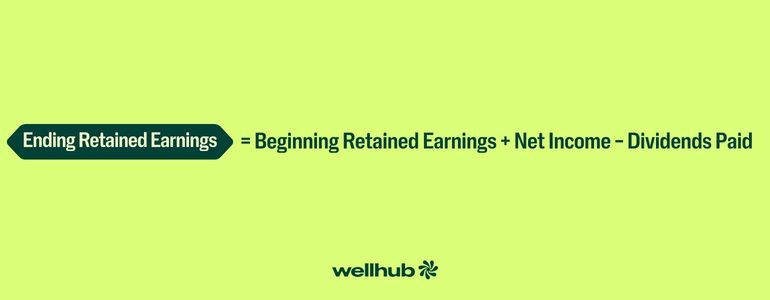How to Use a Statement of Retained Earnings to Drive Business Growth
Last Updated Jan 30, 2025

What’s the secret weapon for growth-focused organizations? The statement of retained earnings.
While income statements and balance sheets often grab the spotlight, this unsung hero offers powerful insights into financial health. For CEOs and CFOs, it’s more than just a report—it’s a strategic guide to leveraging profits for future investments and boosting stakeholder confidence.
When you understand the statement of retained earnings, you gain a tool to drive smarter reinvestments, enhance transparency, and strengthen trust. Use this financial powerhouse to sharpen your strategy and build lasting value for your organization.
What Is a Statement of Retained Earnings?
A statement of retained earnings is a financial snapshot that tracks how your company’s retained earnings—those reinvested profits—change over a specific period, like a quarter or fiscal year. It outlines how net income, dividends, and other factors shape the retained earnings balance, giving you a clear picture of how much profit fuels your business’s growth instead of being distributed to shareholders.
Retained earnings aren’t just numbers on a page—they’re the foundation of your company’s future. They show your ability to fund innovation, expand operations, and strengthen financial health, all while building trust with stakeholders. This statement highlights how reinvested profits can power long-term success, making it a must-have tool for understanding and optimizing your company’s growth potential.
Why Retained Earnings are Critical in Corporate Finance
For executives, understanding and effectively communicating retained earnings is about more than numbers—it’s about telling a compelling story of stability and forward momentum. Investors and stakeholders value that story because it builds trust, guides decision-making, and secures support for future growth. Here’s how a statement of retained earnings can shape your corporate strategy:
- Fueling Strategic Investments: Retained earnings offer flexibility to fund growth initiatives without additional debt. Whether it’s investing in cutting-edge technology, entering new markets, or scaling production, these profits give leaders the tools to drive meaningful progress.
- Signaling Financial Stability: High retained earnings signal strong profitability and sound financial management. Investors and stakeholders see this as a marker of stability, especially when there’s evidence of smart reinvestment. A robust statement of retained earnings shows your company has the resources to pursue growth, inspiring confidence across the board.
- Boosting Company Valuation: A healthy statement of retained earnings can enhance your company’s valuation. Regularly reinvesting in high-impact areas signals sustainable growth, which boosts perceived value and can elevate stock prices over time. Conversely, stagnant or declining retained earnings may prompt questions about your growth strategy or dividend policies.
A well-managed statement of retained earnings reflects resilience and ambition. For C-suite leaders, it’s a strategic tool that keeps you aligned with the company’s trajectory—ready to make decisions that drive immediate impact and long-term success.
How to Calculate Retained Earnings
To actually leverage the power of a statement of retained earnings, you must first know how the formula works. Fully grasping how to calculate retained earnings not only gives you a figure to work with but also better insights into your financial health and reinvestment effectiveness.

Key Components of the Statement of Retained Earnings
The statement of retained earnings is a window into your company’s growth story. Let’s take a look at each component to see what it means for your strategy:
- Beginning Retained Earnings: This is your starting line—the profits carried over from the previous period. It shows how your company’s accumulated income has grown (or shrunk) over time. For leaders, this figure offers a clear benchmark to evaluate how past reinvestments or dividends have shaped growth.
- Net Income (or Loss): This is the heartbeat of your financial performance. Tied to your income statement, it reflects the profits earned (or losses incurred) during the reporting period. A strong net income strengthens retained earnings, signaling robust performance. A loss, however, subtracts from the total, prompting leaders to dig deeper into what went wrong—and how to pivot.
- Dividends Paid: Dividends represent a slice of your profits returned to shareholders, reducing retained earnings. While they boost investor confidence, holding onto those funds creates opportunities for reinvestment and growth. Striking the right balance between distributing dividends and fueling business expansion is a critical strategic call for any executive.
- Ending Retained Earnings: This is where it all comes together. By adding net income to beginning retained earnings and subtracting dividends, you get the final balance. It’s a powerful indicator of how effectively your company is managing and reinvesting profits. A steady upward trend here? That’s the hallmark of smart financial management and a forward-thinking growth strategy.
Each number in the statement tells a story. For executives, this isn’t just about reporting—it’s about crafting a narrative of success, making strategic decisions, and charting the course for sustained growth.
Calculating Retained Earnings, Step-by-Step
Creating a statement of retained earnings is a straightforward process that ties your past profits to future opportunities. Here’s how it works:
- Start with the Heading
At the top of the statement, include:
- Company Name
- The title: “Statement of Retained Earnings”
- The reporting period (e.g., “For the Year Ending December 31, 2023”).
- Report Beginning Retained Earnings
Pull the retained earnings from the end of the last reporting period. This is your opening balance and serves as the foundation for the current period’s statement. For example, if your retained earnings at the close of last year were $500,000, that’s your starting point.
- Add Net Income (or Subtract Net Loss)
From your income statement, include the net income (or loss) for the reporting period. This figure reflects your profitability during the time frame.
- Subtract Dividends Paid
If dividends were distributed to shareholders, deduct those from your retained earnings. This step highlights how much profit was shared externally versus reinvested into the business. For example, if you paid $50,000 in dividends, subtract that amount to determine the profit retained.
- Calculate Ending Retained Earnings
Combine these elements using the formula:
Ending Retained Earnings = Beginning Retained Earnings + Net Income – Dividends Paid
This figure becomes the starting point for the next reporting period.
Example Statement
- Beginning Retained Earnings: $500,000
- Plus Net Income: $200,000
- Minus Dividends: ($50,000)
- Ending Retained Earnings: $650,000
Examples of Retained Earnings Statements in Action
So, what does a statement of retained earnings look like in practice? These examples can give you a better idea of what calculations really look like and how these figures are leveraged in the real world.
Example 1: Prioritizing Reinvestment for Growth
Scenario: A software company starts with $1.2 million in retained earnings, generates $500,000 in net income, and pays no dividends.
Statement:
- Beginning Retained Earnings: $1,200,000
- Plus Net Income: $500,000
- Minus Dividends: $0
- Ending Retained Earnings: $1,700,000
Strategic Insight: By reinvesting all profits, the company signals a commitment to innovation and long-term growth. This approach can appeal to investors focused on future returns.
Example 2: Recovering After a Loss
Scenario: A manufacturing firm begins with $2 million in retained earnings, experiences a $100,000 loss, and distributes $50,000 in dividends.
Statement:
- Beginning Retained Earnings: $2,000,000
- Plus Net Income (Loss): ($100,000)
- Minus Dividends: ($50,000)
- Ending Retained Earnings: $1,850,000
Strategic Insight: The reduced balance underscores the need for careful planning. Leadership might focus on cost-cutting or new revenue streams to stabilize financial performance.
Leveraging A Statement of Retained Earnings for Long-Term Success
When used strategically, a statement of retained earnings can fund initiatives that ensure a company’s growth, resilience, and market leadership. Here are some strategies to consider:
Fueling Business Expansion
Reinvesting retained earnings into key areas such as research and development, new market entry, or scaling operations can unlock new revenue streams. For example, companies like Apple often allocate significant funds to product innovation. You can also use retained earnings to better support employees — after all, 85% of employees believe their employer has a responsibility to help them tend to their wellbeing. This helps with employee retention and job satisfaction, which stabilizes your company, too.
Strengthening Financial Stability
Using retained earnings to pay down debt or bolster cash reserves can improve a company’s financial wellbeing. This strategy reduces risk exposure and reassures stakeholders that the business is prepared to weather economic uncertainties.
Building Shareholder Trust
Retained earnings also play a role in demonstrating management’s commitment to growth. Whether reinvested internally or distributed through dividends, they reflect a leadership team’s ability to balance profitability with shareholder value.
Presentation Tips for Executives
When presenting retained earnings at board meetings or to investors, focus on clarity and strategic budgeting. Highlight:
- Key investments: Show how funds are being used to drive growth.
- Projected returns: Tie retained earnings decisions to anticipated outcomes, such as revenue growth or market expansion.
- Alignment with goals: Emphasize how reinvestment aligns with the company’s long-term vision.
Navigating Challenges and Opportunities in Retained Earnings
Managing retained earnings is a balancing act between reinvesting profits, rewarding shareholders, and maintaining financial stability. Common challenges include:
- Balancing reinvestment and dividends: Reinvesting profits can drive growth, but shareholders often expect consistent payouts.
- Managing shareholder expectations: When dividends are reduced to prioritize reinvestment, some investors may view it as a lack of confidence in the business.
- Maximizing reinvestment returns: Without careful planning, reinvested funds may not deliver the growth or ROI needed to justify the decision.
- Building a financial safety net: Retained earnings offer stability, but not setting aside enough can leave a company vulnerable to economic downturns.
You can tackle these challenges by:
- Balancing reinvestment and dividends: Define a clear split between reinvestment and payouts. Communicate this strategy to stakeholders, and adjust as financial performance or market conditions change.
- Managing shareholder expectations: Use retained earnings reports to show how profits are fueling growth. Highlight past successes like new product launches or increased market share to build confidence.
- Maximizing reinvestment returns: Focus on scalable projects with high ROI, such as expanding into new markets or automating operations. Track outcomes to refine your approach.
- Building a safety net: Allocate a portion of retained earnings to an emergency fund. This protects your business during downturns or unexpected challenges.
Enhancing Organizational Financial Wellness through Effective Financial Management
What if your financial strategy could do more than drive profits? By effectively managing retained earnings, businesses create a ripple effect that fuels growth, resilience, and employee wellbeing.
Strategic reinvestments don’t just benefit operations or innovation — they can directly impact your workforce. Allocating retained earnings toward employee wellness programs is one of the smartest moves a company can make. Why? Simple: 95% of companies tracking ROI see positive returns on their wellbeing programs — and over half get more than $2 back for every $1 invested. These programs help improve employee health, which translates into higher productivity, lower absenteeism, and stronger retention rates.
Speak with a Wellbeing Specialist to learn how Wellhub can support your workforce and your bottom line!

Company healthcare costs drop by up to 35% with Wellhub*
See how we can help you reduce your healthcare spending.
[*] Based on proprietary research comparing healthcare costs of active Wellhub users to non-users.
You May Also Like:
- Decoding W-2 and W-4: Essential Knowledge for HR Leaders
- Everything You Need To Know About Using Straight Time
- What is a Pay Equity Analysis?
Resources
- Wellhub (2024, May 16). Return on Wellbeing 2024. https://wellhub.com/en-us/resources/research/return-on-wellbeing-2024/
- Wellhub (2024, October 16). The State of Work-Life Wellness 2025. https://wellhub.com/en-us/resources/research/work-life-wellness-report-2025/
Category
Share

The Wellhub Editorial Team empowers HR leaders to support worker wellbeing. Our original research, trend analyses, and helpful how-tos provide the tools they need to improve workforce wellness in today's fast-shifting professional landscape.
Subscribe
Our weekly newsletter is your source of education and inspiration to help you create a corporate wellness program that actually matters.
Subscribe
Our weekly newsletter is your source of education and inspiration to help you create a corporate wellness program that actually matters.
You May Also Like

Vision Statement: Examples and Tips For Writing One | Wellhub
Leverage these tips to write a powerful vision statement that shapes your company's goals and culture, creating a lasting business impact.

Business Management: Skills, Benefits, and Strategies
Use these tips to improve business management skills, enhance employee engagement, and build a stronger foundation for organizational success.

Profit and Loss Statement: Key Elements, Analysis Tips | Wellhub
The P&L is a financial snapshot of a business's income and expenses over time. Unlock the key to strategic decision-making.